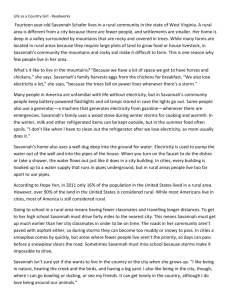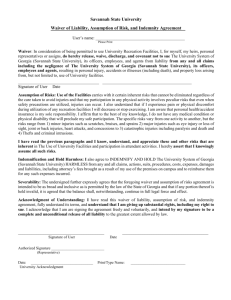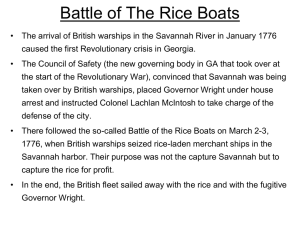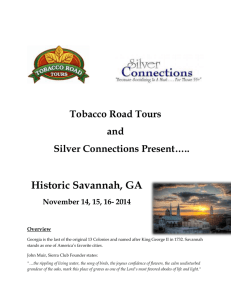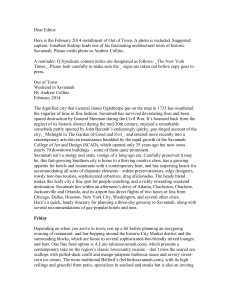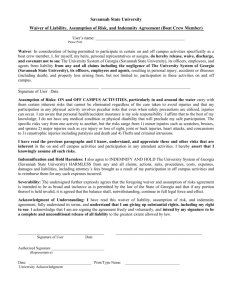Primary Sources - Virtual Historic Savannah Project
advertisement
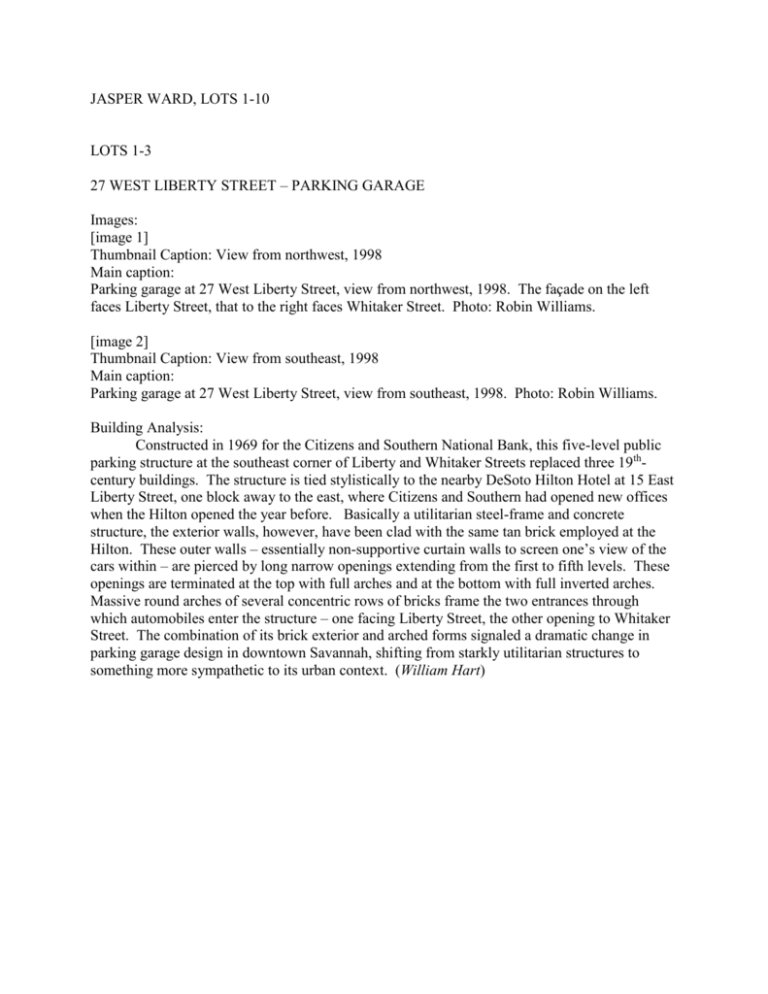
JASPER WARD, LOTS 1-10 LOTS 1-3 27 WEST LIBERTY STREET – PARKING GARAGE Images: [image 1] Thumbnail Caption: View from northwest, 1998 Main caption: Parking garage at 27 West Liberty Street, view from northwest, 1998. The façade on the left faces Liberty Street, that to the right faces Whitaker Street. Photo: Robin Williams. [image 2] Thumbnail Caption: View from southeast, 1998 Main caption: Parking garage at 27 West Liberty Street, view from southeast, 1998. Photo: Robin Williams. Building Analysis: Constructed in 1969 for the Citizens and Southern National Bank, this five-level public parking structure at the southeast corner of Liberty and Whitaker Streets replaced three 19thcentury buildings. The structure is tied stylistically to the nearby DeSoto Hilton Hotel at 15 East Liberty Street, one block away to the east, where Citizens and Southern had opened new offices when the Hilton opened the year before. Basically a utilitarian steel-frame and concrete structure, the exterior walls, however, have been clad with the same tan brick employed at the Hilton. These outer walls – essentially non-supportive curtain walls to screen one’s view of the cars within – are pierced by long narrow openings extending from the first to fifth levels. These openings are terminated at the top with full arches and at the bottom with full inverted arches. Massive round arches of several concentric rows of bricks frame the two entrances through which automobiles enter the structure – one facing Liberty Street, the other opening to Whitaker Street. The combination of its brick exterior and arched forms signaled a dramatic change in parking garage design in downtown Savannah, shifting from starkly utilitarian structures to something more sympathetic to its urban context. (William Hart) LOT 5 3 WEST LIBERTY STREET IMAGES: [image 1] Thumbnail Caption: View from north, c.1893 Main caption: 3 West Liberty Street, view from the north east, showing the original design of the house with an iron balcony facing Bull Street on the left and a recessed west wing to the right. Photo: from Charles Hart Olmstead, Art Work of Savannah, Chicago: Parish, 1893. Reproduced courtesy of the Georgia Historical Society. [image 2] Thumbnail Caption: View from east with Georgia Hussars, 1908 Main caption: Georgia Hussars on parade on Bull Street, with their headquarters at 3 West Liberty Street visible in the background, 1908. Photo: Cordray-Foltz Collection 1360, ST022.20-01, Georgia Historical Society. [image 3] Thumbnail Caption: View from east, c.1911 Main caption: 3 West Liberty Street, view from the east, showing the addition of shops along Bull Street below the side verandah. Photo: from Joseph F. Gray, ed., Savannah, Savannah: Savannah Chamber of Commerce, 1911, p.40. Reproduced courtesy of the Georgia Historical Society. BUILDING ANALYSIS Constructed circa 1850 for Joseph Fay, 3 West Liberty Street was likely designed by John S. Norris. One of the most active architects in Savannah prior to the Civil War, Norris was typical of his generation in employing a range of architectural styles – Neoclassical, Gothic revival, and Italianate. He specialized in symmetrically composed house designs that complemented the formality of the city’s urban setting. His design for 3 West Liberty, however, was unusual both for Norris and for Savannah because of its Italian Villa style and picturesque composition. Characterized by unadorned exterior stucco walls, low-pitched gabled roofs and overhanging eaves supported by wooden brackets, this style appealed to the growing idealistic fascination with rural life during the mid-19th century. The location of the house at what was then the southern edge of Savannah may have inspired the use of this style. The house has undergone numerous modifications and additions over the years, with the most obvious being on the main façade overlooking Liberty Street – the filling in of the secondfloor windows, the addition of a shop in place of the verandah on the east side, and the reconfiguring of the west wing so that its formerly recessed wall aligned with that of the main façade. The cumulative effect of these changes dramatically diminished the unusual picturesque character of the original design. 3 West Liberty Street served a residential purpose until 1896, when the DeRenne family sold it to the Georgia Hussars, a volunteer militia group who made it their headquarters. The house provided a backdrop for the Georgia Hussars when they proudly paraded in full regalia on Bull Street. In the 1920s the Roman Catholic diocese acquired the building, which then accommodated the Knights of Columbus, a Catholic fraternal organization, for use as its headquarters. Formally purchasing the building in the 1960s, the Knights of Columbus continue to occupy the house, which they largely restored in 1999. (RBW) Bibliography: Primary Sources: 1849 Tax Digest Records for the City of Savannah. Georgia Historical Society. “Savannah City Directories.” 1890, p.223 “Savannah City Directories.” 1891, p.224. “Savannah City Directories.” 1894, p.230. “Savannah City Directories.” 1896, p.120. “Savannah City Directories.” 1899, p.125. “Savannah City Directories.” 1902, p.127. “Untitled.” Savannah Morning News, December 24, 1878. Secondary Sources: Morrison, Mary Lane. John S. Norris, Architecture in Savannah, 1846-1860. Savannah: Beehive Press, 1980, p.25, ill. p.26. Morrison, Mary Lane, ed.. Historic Savannah. Charlottesville: Historic Savannah Foundation, 1979, p.122, figure 21.1. Morrison, Mary Lane. John S. Norris Collection: 1320, Notebook No. 1, document attributing Norris to building. Toledano, Roulhac. The National Trust Guide to Savannah. New York: Preservation Press, 1997, pp.38 & 144. (Compiled by Amanda St. Vincent) LOT 5 307-09 BULL STREET Building Analysis: Built in 1897 for the Georgia Hussars, this storefront building with generous display windows facing Bull Street added a distinctly exotic quality to the romantically designed real estate the Hussars owned on this block of Jasper Ward. In contrast to the rather austere Italian villa style of the Georgia Hussars headquarters around the corner at 3 West Liberty Street, these shops were designed in an exuberant Venetian Gothic manner, characterized by a fanciful terracotta arcade of spiraling columns, ogee arches topped by pinnacles and a parapet of quatrefoils. The four large plate-glass display windows, especially the curving corner windows, testify to the remarkable advances in glass-making technology during the late 19th century. The eye-catching shops took full advantage of a location directly across from the entrance to the Hotel DeSoto, the most fashionable hotel in the city. The presence of an iron railing atop the building during the early 20th century suggests it accommodated a roof-top terrace. The first stores to lease the building were the A.P. Flint and Adv. and Exhibiting Company (a watch, clock and jewelry store) at 307 Bull St. and the DeSoto Pharmacy, run by H.H. Livingston. In 1923, the Hubert Motor Company (later renamed the J.C. Lewis Motor Company) took over both halves of the building for a Ford dealership, demolishing the central dividing wall in the process, to serve as one of the earliest automobile showrooms in the country. , (RBW) Image: Thumbnail Caption: View from east, 1998 Main caption: Shops at 307-9 Bull Street, view from east, 1998. Photo: Daniel Koster. Bibliography: LOTS 6-7 SORREL-WEED HOUSE 6 West Harris Street Lots 6-7, Jasper Ward Architect: attributed to Charles B. Cluskey 1839-41 Images: [image 1] Thumbnail Caption: View from south east, 1998 Main caption: Sorrel-Weed House, view from the south east, 1998, showing the house shortly after its restoration, including the reconstruction of the east verandah. Photo: Daniel Koster. [image 2] Thumbnail Caption: View from south, 1998 Main caption: Sorrel-Weed House, view from the south from Madison Square, 1998, showing the house shortly after its restoration. Photo: Daniel Koster. [image 3] Thumbnail Caption: View from south east, c.1930 Main caption: Sorrel-Weed House, view from the south east, c.1930, showing the house in its original condition except for the addition of the brick garden wall facing Bull Street. Photo: HABS photo 14-140; Savannah Historical Research Association Collection 994, Box 7, folder 144, Georgia Historical Society. Building Analysis: The Sorrel-Weed House illustrates the importance placed by Savannah’s wealthy citizens on the home as a center of social activity and expression of social aspiration. Built for Francis Sorrel, head of the local branch office of Douglas and Company Mercantile, the house epitomizes the fashionable preference for the Greek Revival style during the 1830s and 40s in America and especially in the south. Born in the French colony of Santo Domingo and arriving in Savannah in 1820, Sorrel purchased the prominent lot-and-a-half site overlooking Madison Square at 6 West Harris Street in 1837 and by 1839 had begun construction of the house. The design is attributed to Charles B. Cluskey, Georgia’s leading architect at the time. The two-story house reflected the growing prosperity and nascent fire codes in brick construction, which was covered with stucco scored to look like massive masonry blocks and tinted ochre. The overall simplicity of the exterior and the delicate precision of its main features – the projecting portico of two Doric columns in antis and the recessed round arches to the sides – recall the house designs by William Jay for Savannah’s elite a generation earlier. The greater archeological accuracy of the Doric columns and the patterns in the iron grill work are typical of the Greek Revival. The plan of the house was inspired by plate 59 in Biddle and Havilland’s Young Carpenter’s Assistant, published in 1837. Its central hall plan, a favorite of the Greek Revivalists, was the perfect solution for Savannah’s coastal climate, as breezes were funneled through the hallways and in summer it was likely to be the coolest area of the house. All the rooms on the main floor were designed to open onto verandahs. These one-story porches on three sides of the house not only provided shade for the important windows, but also served as extended living areas. Other notable interior features include a main circular staircase, eight marble fireplaces and gilded cornices atop the drawing room and dining room windows. After its completion in 1841, the elegant home became a fashionable salon for the aristocracy of Savannah. The biggest social event that took place in the house was the marriage of Aminta Sorrel to General William Whann Mackall in 1843. Some years later, her halfbrother, Gilbert Moxley Sorrel, who later served under General James Longstreet as an assistant adjutant general in the Confederate army, utilized the western portion of the adjoining lot as a site for the construction of a three-storied house. In 1859, the family moved to that new building upon the sale of 6 West Harris Street to Henry Davis Weed, a wealthy merchant from New England who carried on the great social traditions of the house. In 1862 Robert E. Lee paid a visit when he was in charge of the Confederate coastal region. The residence stayed in the possession of the Weed family until 1914. The house has experienced a much more checkered history during the 20th century. Following the departure of the Weeds, the house sat empty, except to serve briefly as the headquarters for the campaign of the Bishop’s Confraternity of the Laity. The Cathedral Young People’s Association secured the property as a clubhouse and activity center in 1939. A living room, library, sewing room, pool room, cooking room and even a gym for the boxing team were to be arranged. Then in 1940, the Society for the Preservation of Savannah Landmarks marked its first activity with the opening of the Sorrel-Weed House as an “interesting example of early Nineteenth Century architectural taste” along with an exhibit of 18th and 19th-century furniture and fine arts. Mrs. Mildred K. Cohen purchased the property on November 1, 1941 with the intention of dividing the house into apartments. In 1946, the eastern verandah was replaced by The Lady Jane Shop, a one-story store facing Bull Street. The simple boxy form, exposed Savannah Grey bricks (taken from the original garden retaining wall) and projection out to the Harris Street lot line all served to upset the careful symmetry of Cluskey’s original design. Despite such changes, the house received its historical marker from the State of Georgia in 1954. In 1977, Mildred’s son Abram J. Cohen inherited the property, added a deck linking the house to its carriage house and undertook relatively minor modifications to the interior. Most recently, the Sorrel-Weed House was purchased by Stephen Bader with the goal of restoring the home to its original 1840s form, enlisting the help of John Deering of Hansen Architects. In 1996, The Lady Jane Shop and the rear deck were torn down to make way for the reconstruction of the east and north verandahs, which were completed in 1998. The restoration of the original ochre color caused a very public controversy among area residents and rejection by the Savannah Historic Review Board. A more muted shade of ochre was eventually employed. Following the completion of the $2,000,000 restoration of the Sorrel-Weed House, Bader plans to reinstate the entertaining traditions established by Francis Sorrel and Henry Davis Weed. (Ruth Ann George) Bibliography: Primary Sources: Cohen, Abram J. and Mildred K. Collection, Folders 1-3. Collection No. 1197, Georgia Historical Society. Hartridge, Walter Charlton Collection, Folders 3101-3119, Box 184. Collection No. 1349, Georgia Historical Society. McDonough, James Vernon Collection, Folder 44. Collection No. 1343, Georgia Historical Society. Morrison, Mary Lane Papers Collection, Notebook 3. Collection No. 1320, Georgia Historical Society. Sanborn Company. Insurance Maps of Savannah Georgia, Volume 1. New York: Sanborn Company, 1955, plate 24. Georgia Historical Society. Savannah Daily Georgian, October 23, 1841, page 2, column 4. Savannah Historical Research Association Papers Collection, Folder 144, Box 7. Collection No. 994, Georgia Historical Society. “Savannah Improvements.” Savannah Daily Georgian, September 27, 1839, page 2, column 4. Ward Books, Jasper, Jackson/Lafayette Ward. Georgia Historical Society, pp. 4-5, figure p. 4. Secondary Sources: Biddle, Owen. Young Carpenter’s Assistant, Reprint of the 1837 Revised Edition. Ann Arbor: University Microfilms International, 1985, plate 59. “Cathedral Youth Get Weed House.” Savannah Evening Press, May 20, 1939. “Cohen’s Roof Garden is Hidden NOG Garden.” Savannah Morning News, April 22, 1979. Federal Writer’s Project in Georgia Works Progress Administration. Savannah. Savannah: Review Printing Company, 1937, p. 101. Fogaley, Richard. “Restoring the Past.” Savannah Morning News, January 26, 1997. Freeman, Ron. Savannah: People, Places and Events. Savannah: H. Ronald Freeman, 1968, pp. 107-108. Historic Savannah Foundation. Historic Savannah. Savannah: Historic Savannah Foundation, 1968, pp. 26, 151, 153, figures pp. 32 & 153. “Hostesses Assigned for the Weed House.” Savannah Morning News, January 5, 1940. “House Color, Hotel Height To Be Decided This Week.” Savannah Morning News, September 9, 1997. Lane, Mills. Architecture of the Old South: Greek Revival and Romantic. Savannah: Beehive Press, 1996, pp. 101-107, figure p. 107. Lane, Mills. Savannah Revisited: Her History and Architecture. Savannah: Beehive Press, 1994, pp. 128, 139, 145, figure pp.144-145. Linley, John. The Georgia Catalog. Athens: The University of Georgia Press, 1982, pp. 67, 112, 281, 312, 325, 326, 331, 335, 339, 342. Morrison, Mary Lane, ed. Historic Savannah. Savannah: Historic Savannah Foundation, 1979, p.122, figure 21.3 & ill. p.xix. “Orange House Color Won’t Do.” Savannah Morning News, August 19, 1997. “Savannah Gas Company Called City’s Oldest Public Servant.” Savannah Morning News, n.d. Sewell, Cliff. Savannah Now and Then. Savannah: Printcraft Press, 1974, pp. 33-35. Sieg, Edward Chan. The Squares: An Introduction to Savannah. Norfolk: The Donning Company, 1984, pp. 75 & 186, figures pp. 75 & 186. Society for the Preservation of Savannah Landmarks. A Loan Exhibit of Furniture and Fine Arts XVIII and XIX Centuries at the Sorrel-Weed House on Madison Square. Savannah: Review Press, 1940. “Sorrel-Weed House.” Savannah Morning News, March 17, 1940. “Sorrel-Weed House Exhibit Praised.” Savannah Morning News, April 16, 1940. Toledano, Roulhac. The National Trust Guide to Savannah. New York: Preservation Press, 1997, pp. 124-125, 146, figure p.146. “Volunteer Workers Meet at Weed Home.” Savannah Morning News, January 5, 1940. “Weed House to Open Next Month.” Savannah Evening Press, November 25, 1939. “Weed House to Open This Week.” Savannah Morning News, January 7, 1940. Compiled by Ruth Ann George LOT 8 14-18 WEST HARRIS STREET Building Analysis: The Kerr residences at 14 & 18 West Harris Street testify to the strong social connections made by Irish immigrants to Savannah during the 19th century. Eugenia and Louisa Kerr, a pair of sisters, arrived in Savannah from Ireland sometime in the 1830s and joined the Hibernian Society by 1839. In 1840, they purchased lot 8 of Jasper Ward for $800 from a Michael Dillon, a fellow Hibernian Society member. The pair of townhouses, the first in Savannah to be designed in the fashionable Greek Revival style, has been attributed to Charles B. Cluskey, the leading architect in the city and also a Hibernian. Erected in 1842, the Kerr houses illustrate the simplicity and elegance of Greek Revival with their pedimented window heads, refined detailing and delicate ironwork. Typical of Cluskey and other Greek-Revival architects was the goal of communicating in a rational way the inner workings of a building: here, the entrance bays subtly project outward to differentiate the circulation spaces of the side hall plans within from the principal living areas. Unlike rows of townhouses, where the entrance to each house is situated on the same side, this pair of houses employs reflecting plans, so that the entrances frame what appears to be a very generous living area at the center. Image: Thumbnail Caption: View from south east, 1998 Main caption: 14-18 West Harris Street, view from south east, 1998. Photo: Daniel Koster. [Move carriage house photo to separate model of the carriage house] Bibliography: Secondary Sources: Lane, Mills. Savannah Revisited. Savannah: Beehive Press, 1994, pp.139 & 146. Morrison, Mary Lane, ed. Historic Savannah. Savannah: Historic Savannah Foundation, 1979, p.122 and figure 21.5 on p.123. Tolendo, Roulhac. The National Trust Guide to Savannah. New York: Preservation Press, 1997, pp.146-147. LOT 9 20-22 WEST HARRIS STREET Image: Thumbnail Caption: View from south east, 1998 Main caption: 20-22 West Harris Street, view from south east, 1998. Photo: Daniel Koster. LOT 10 (east half) 24 WEST HARRIS STREET Thumbnail Caption: View from south east, 1998 Main caption: 24 West Harris Street, view from south east, 1998. Photo: Daniel Koster. Building Analysis: Bibliography: Secondary Sources: Morrison, Mary Lane, ed. Historic Savannah. Savannah: Historic Savannah Foundation, 1979, p.122. Sieg, Gerald Chan. “The Wiegands: A Family of Famous Musicians,” Savannah Morning News Magazine, July 24, 1966, pp.4-5. LOT 10 (west half) 26 WEST HARRIS STREET Building Analysis: This two-story building at the northeast corner of Harris and Whitaker Streets nicely illustrates the often-radical nature of alterations made to buildings over time due to changing social or economic needs. Originally constructed in the 1840s as a house for John B. Gallie, the building stood three stories tall, crowned by a gable roof. Little else is known about its design. Conversion from residential to commercial usage took place in 1913, when its then-owner Dr. B. P. Oliveras applied for a building permit to “extend and remodel” the brick building at this address – presumably the former Gallie house. The terse permit entry belies the extent of the remodeling: the removal of the third story, the replacement of the gable roof for a flat one, the reorientation of the building so that its principal façade fronted Whitaker Street (instead of Harris Street), the doubling of the length of the building, and the installation of large store windows and doors along its Whitaker Street façade. The building here maintained the same tenants for many years. The Steven Rabey Paint Company occupied the first floor space facing Whitaker for approximately forty years, while the DeKalb Hall of the International Order of Odd Fellows occupied the second floor space for over fifty years. The Savannah College of Art and Design acquired 25 West Harris Street in the early 1990s. The college closed in the shop windows, re-oriented the entrance back to Harris Street and restuccoed the exterior, giving the building a character that was no longer overtly commercial or particularly residential. Known as the “Harris Street Building” at the college, it houses administrative offices. (William Hart and RBW) Bibliography: Secondary Sources: Morrison, Mary Lane, ed. Historic Savannah. Savannah: Historic Savannah Foundation, 1979, p.122. IMAGES: [None currently attached; I’ll send some to you]

